ECONOMIC WAR ON THE FAMILY
Let me begin by stating that the basic unit of society is the family, not the individual. Let us never forget that Jesus Christ Himself chose to come into the world via a family, thereby showing the importance of this institution. Without denigrating those who have chosen to live a single life, either in the world or in religous life, I want to stress the ongoing attack on the immediate family. Even though the extended family–that includes older parents, siblings and close relatives, etc.–suffers the same fate, the entire thing is under attack.
The family is facing an onslaught from a variety of attackers. Certainly, the very institution of the immediate family, in which I include a man and a woman, united in marriage, and the children that are produced in that marriage–that institution is being attacked by the prevalence and even endorsement of governments and corporations of same-sex unions. The family is also threatened by the prevalence of easy divorce and almost as easy annulments. Family life is further undermined by a variety of immoral or at least culturally disastrous forms of entertainment directed at young people, and by the widespread distribution of both printed and electronic pornography. I contend that pornography is as much a reason for widespread divorce as anything.
And perhaps the greatest harm being done to families is the widespread leaving of the home by mothers who enter the workplace. I can't tell you how many mothers I know who are working and would love to be at home raising their children. The greatest reason for this situation is that we live at a time almost unheard-of 40 years ago, where one spouse must work to earn the family's needs and the other must have an income to pay an accumulation of taxes. The toll on children and on family life generally is enormous. And it's this last threat to family life that I'll focus on: the economic aspect of the attack on the family.
I'll begin with some wisdom about this topic given by St. Thomas Aquinas. At one spot, he talks about the need for material goods. He says that for a man to live a virtuous life, two things are required. The chief requisite is virtuous action, for virtue is that by which one leads a good life. The other requisite, which is secondary and quasi-instrumental in character, is a sufficiency of material goods, the use of which is necessary for virtuous action.
He then goes on to talk about money and the need for stability of value. He says that as a measure used for estimating the value of things, money must keep the same value. This is because the value of all things must be expressed in terms of money. Thus, exchanges can readily take place, and, as a consequence, communications between men are facilitated. But who has the responsibility to make sure that money has this stability of value?
St. Thomas says the State must establish this stability, both in the measure of weight, length and value. It is true that it is the same with money as with other things, namely, that one does not always get what one wants for it because it is not often endowed with the same purchasing power. That is, it is not always endowed with the same value. Nevertheless, according to St. Thomas, matters should be so arranged by the State that it should be steadier in value than other things. As a measure used for estimating the value of other things, money must keep the same value since the value of all things must be expressed in terms of money.
Before considering the subject of the Federal Reserve, it is worth noting a quote from St. Pius X. In 1906, he wrote a letter to the bishop of Madrid in which he says,
All must remember that nobody has the right to remain indifferent when religion or the public welfare are in danger. Those who strive to destroy religion and civil society aim above all at getting control, as far as possible, of the direction of public affairs and of having themselves chosen legislators. It is therefore necessary that Catholics should strive with all their might to avert that danger.
Pope St. Pius X is telling us that we who are in the world have responsibilities in the world. We even have responsibilities in what is often called "the dirty business" of politics. Instead of the term "politics," however, I prefer the terms "right and wrong," "morality" and so on. The subject of money, however, deserves our special attention. Perhaps most Catholics never consider this issue, but it's something that people need to know.
What is money? It's a commodity used for exchange. The important word, however, is not exchange. The important word is commodity. A commodity is something that has a value in and of itself. Over the course of history, there were many items used for money. They actually used tobacco at one time for money. Cattle, seashells, and nails were used for money, the latter even in the time of the rise of our nation before the breakaway from England. Even salt was used for money at one point, which is the origin of our word salary.
All of these substances, however, had a common problem. Tobacco rotted; something more durable was needed. Cattle were inefficient for small transactions and you had to feed the money! Seashells worked until someone found a new beach full of seashells and then flooded the market, driving down their value. After a time, nails and salt became imported more frequently, thus becoming less valuable. Money, then, to be useful and to be a commodity used for exchange, must be valuable, divisible, durable, and most importantly, scarce.
All throughout the course of history, people have decided that the best substance to use as money is gold. Why gold? It's attractive, useful (even in today's electronic industry), divisible (it can be made into bars, coins, dust, etc.), durable (inert) and scarce. Where it exists in nature it is difficult to extract from the earth, takes a lot of effort and therefore cannot be diluted in value like so many other things. Gold gives money stability and a measure of worth. This is important and is exactly what St. Thomas talks about.
 |
Thus, when gold is the money of a nation, that nation has sound money. And sound money allows for a diversity of labor. There are not too many people who have considered what a diversity of labor means. It means that there are people who can not be producers (and grow their own food, for example), but what they do can be something that can earn them money so that they can buy food. This category includes artists, writers, clergymen, doctors and so forth. Sound money, therefore, is not a product of an advancing civilization; it is the stimulus of an advancing civilization.
We once had sound money in our country, although we don't anymore. We now have paper currency backed by... nothing. How did paper currency ever come to be? Consider the old story of the warehouse. There was once a place with gold currency, but a lot of people who possessed this gold didn't want to leave it in their homes for fear of burglary or abuse. Thus, some enterprising individual in the community opened up a warehouse. He announced that everyone could store their gold in his warehouse for a small fee and that he would give a receipt for it. These receipts were given in ounces and people began to store their gold in his warehouse.
Soon, however, the manager of the warehouse realized that much of the gold was not going in and out, but was remaining in the warehouse. Then he heard that when people wanted to make purchases, they were not coming to get their gold, but were simply using the warehouse receipts, i.e., paper. So the very devious fellow who ran the warehouse came up with a scheme to print extra warehouse receipts and spend them. In a small amount of time, he acquired a great amount of the wealth of the community.
But word eventually spread that there might not be enough gold in the warehouse for all of the receipts. This caused a run on the warehouse with those who arrived first receiving their gold. Eventually, however, there were people with receipts but no more gold left in the warehouse. Thus, the manager was then tried, convicted and executed. This was the beginning of paper money.
It is worth considering in detail various kinds of currency that have been used in the US in the last century. You can see what has happened by observing the change over the years. First, look at a 1922 US Treasury Gold Certificate. There is a small note on the bill which reads, "This certifies that there have been deposited in the Treasury of the United States of America fifty dollars in gold coin payable to the bearer on demand." This is absolutely sound money. But it's gone.
In 1933, President Roosevelt took us off the gold standard and said it was illegal for people in the U.S. to own gold. Everybody was to turn in their gold for paper and patriotic citizens all across America did just that. Some people who were a little bit more savvy, however, did not.
We next see the Silver Certificate, which is still a U.S. Treasury Note, not a Federal Reserve Note. This is 1935. The Silver Certificate reads likewise, "This certifies that there has been deposited in the Treasury of the United States of America one dollar in silver payable to the bearer on demand." Silver is still good money, although not as good as gold. Silver, after all, is more plentiful and rusts. But this also is gone now.
 |
|
The Federal Reserve was created in 1913. We didn't go off the gold standard for 20 more years. In the interim period, Federal Reserve Notes began to be distributed. If you look at a 1928 Federal Reserve Note, it says "Redeemable in gold on demand at the United States Treasury or in gold or lawful money at any Federal Reserve Bank." This circulated alongside U.S. Treasury Gold Certificates. The general attitude of the populace was "Federal Reserve? U.S. Treasury? They're both fine. Either one is as good as the other." And the Federal Reserve took off.
By 1934, there was another kind of Federal Reserve Note. This one reads, "This note is legal tender for all debts, public and private, and is redeemable in lawful money at the United States Treasury or at any Federal Reserve Bank." Consider the story of a gentleman who had a $50 bill that said this. He walked into a bank, put his bill on the counter, and asked the teller, "I would like some lawful money for my $50 bill." The teller was confused and thought he wanted his money in different denominations of bills. The gentleman responded quite logically that all of these bills say that they are redeemable in lawful money and that they cannot be lawful money themselves if they say this. The gentleman thus reiterated his demand for lawful money and the teller called the manager of the bank. The manager asked what was considered lawful money, and the gentleman replied, "Gold or silver perhaps." Of course, the manager had none to give. In the end, the gentleman walked away with his $50 bill, but he had made his point.
Stories like this probably reached Washington D.C., the Federal Reserve and New York (where the real decision-making is done for the Fed). Thus we see that the next currency that came out simply said, "This note is legal tender for all debts, public and private." Redeemable in... nothing. This is where we are still at today. The amount of this currency and therefore the value of it and the interest rates upon it and for it are set by the Federal Reserve.
We often hear about the "Federal Reserve Bank." The paradox is that it's not federal, there are no reserves, and it's not a bank. It is a private organization. If you go to Washington D.C. and look in a telephone directory at the thick section which lists federal agencies, you will look in vain for the Federal Reserve.
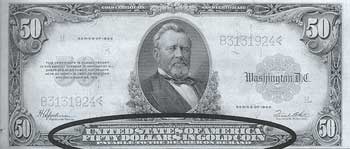 |
1922 US TREASURY GOLD CERTIFICATE This certifies that there have been deposited in the Treasury of the United States of America Fifty Dollars In Gold Coin payable to the bearer on demand |
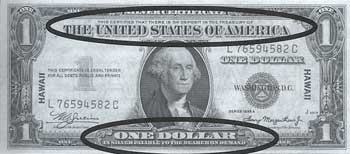 |
1935 US TREASURY SILVER CERTIFICATE This certifies that there is on deposit in the Treasury of the United States of America One Dollar In Silver |
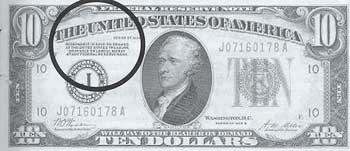 |
1928 FEDERAL RESERVE NOTE redeemable in gold on demand at the United States Treasury, or in gold or lawful money at any Federal Reserve Bank |
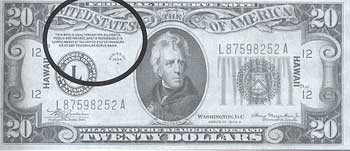 |
1934 FEDERAL RESERVE NOTE This note is legal tender for all debts, public and private, and Is Redeemable In Lawful Money at the United States Treasury, or at any Federal Reserve Bank |
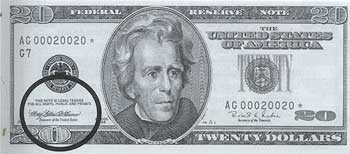 |
1996 FEDERAL RESERVE NOTE This note is legal tender for all debts, public and private |
So we have valueless currency, the amount and value of which are set by a private organization. Consider another story, that of a fellow who goes to a gas station one Sunday and puts $20 of gas in his truck. He goes to the cash register and asks the cashier, "Will you accept a non-redeemable note on a private bank?" At first she said "No," but it was the only money the gentleman had. The cashier called the manager, who gave the exact same response. So the man pulled out a $20 bill and asked, "Are you sure you won't take this?" The girl promptly replied, "Oh, I can take that." "Young lady, this is a non-redeemable note on a private bank."
Are we at a point in the United States of America where our currency could become valueless? In other words, no value? Has it ever happened? It happened in Germany in the 1920's. After World War I, the Versailles Treaty put such heavy, heavy burdens on the Germans for reparations that the German government simply printed Marks and paid the debt. But in the process, the ordinary German citizen lost everything. The money became worthless.
There is a story of a German fellow at this time who had a wheelbarrow full of German currency. He took the wheelbarrow to the store to buy groceries for his family, and left it outside while he shopped. When he came to get the money to purchase the groceries, he found that someone had dumped the money on the ground and stolen the wheelbarrow!
What happened in Germany as a result of this was tremendous bitterness. Then a fellow named Hitler came along and promised to help restore German pride and dig Germans out of the mess that had been created. The German people, by and large, went for it. The rest of the story is known.
What happened in Germany was inflation. We are told unceasingly every day or at least every week in newspapers and magazines, on televisions and radios, that inflation is simply rising prices. This, however, is one of the greatest lies of our time. The truth is that inflation is an increase in the quantity of currency which lowers the value of currency. Therefore, merchants and businessmen and service providers want more of it in return for their goods and services.
To say that inflation is rising prices is equivalent to saying that wet streets cause rain. If you look at a dictionary 50, 60, or even 100 years ago, you will find a good definition of inflation. If you go to a dictionary today, you will not. This means that unfortunately not even a dictionary can be relied upon these days for an accurate definition.
If inflation is an increase in the quantity of currency which lowers its value, it is impossible to have inflation if gold is used as money. In 1940, you could buy a home for $10,000. Today, you can't even make a down payment on a home for $10,000. When I was a boy, my mother would send me to the store for a loaf of bread with a dime. Today, my wife sends me out for the same loaf of bread, but it costs over two dollars. But the bread is still the same bread.
The dollar today is worth less than what a nickel was worth when I was a boy. How did that happen? Was it magic? Often, New Agers and occultists refer to "Magick," which is what the Federal Reserve is. In Roman times, when Christ walked the earth, a one ounce gold coin would buy you a fancy toga, a nice belt, and a pair of sandals. Today, if you had a one ounce gold coin, you could buy a nice suit, a belt and a pair of shoes.
There were still gold coins when I was born called "twenty-dollar gold pieces." A $20 gold piece today costs over $300. If you tell a nine-year-old that a $20 gold piece costs over $300, he will look at you as if you've lost your mind. Why does $20 cost $300? Wouldn't it be nice if those nine-year-olds were our nation's economists?
We have seen the definition of money. We have seen the definition of inflation. There have been many people over the years who were aware of these definitions, but they are usually the very people who used the power of inflation to destroy a nation. John Maynard Keynes, the British socialist who was invited to the U.S. by President Roosevelt to come and reshape the American economic system said we could "spend ourselves into prosperity." Keynes is as responsible for the practice of "deficit spending" as anyone else.
In 1920, Keynes wrote a book called The Economic Consequences of the Peace in which he discusses the Versailles Treaty. He says in this book that
by a continuous process of inflation, governments can confiscate secretly and unobserved an important part of the wealth of their citizens. By this method, they not only confiscate, they confiscate arbitrarily. While the process impoverishes many, it actually enriches some. This process engages all of the hidden forces of economic law on the side of destruction and is done in a manner that not one man in a million can diagnose.
He was right about that, but there are far more than one in a million today who can diagnose what is being done to us. We all need to understand this as well, that inflation is grand theft. Inflation is the taking of the wealth of the people by a consortium of a private institution and government. Therefore, the taking of the wealth in this manner is a tax. Inflation is a tax. Everybody should realize that we get less for our money in a supermarket today than we did last year, and the year before that. A $10 bill used to fill a wagon full of food. Now you would need well over $100 to do that.
Every once in a while an individual comes along and tries to help people find an explanation for what is going on. Occasionally, this comes from an unlikely source like National Geographic magazine. In the January 1993 issue of National Geographic, there is an article entitled "The Power of Money" by Peter T. White. He discusses the various circumstances of money, the history of it, contemporary monies across the globe, etc. Finally he ended up at the Federal Reserve. While he was there, he discovered that the Federal Reserve had recently purchased $100,000,000 worth of U.S. Treasury bills.
This caused him to ask some further questions. He asked a Fed official where the Federal Reserve got this money in the first place. "We created it" was the reply. What he means is that every time the Central Bank writes a check, it creates money. "It's money that didn't exist before," says the official. Imagine the consequences of this capability.
Mr. White further asked the Fed official, "Is there any limit on that?" His reply was that "There is no limit beyond the good judgment and conscience of the responsible Federal Reserve people." Sleep well. We can all sleep well knowing that, my friends. But where did the Fed get this vast authority? It was delegated to them in the Federal Reserve Act of 1913, based on the Constitution's Article I, Section 8: "Congress shall have the power to coin money and regulate the value thereof." Although the Constitution does state this, it does not mean the Federal Reserve has the right to do what it is doing.
What does this mean, then? It means simply that Congress should set up a mint where people could bring their gold or silver and have it made into coins of a fixed size, weight and purity. This is coin money, which is impossible with paper. This was the only authority given to the US Congress regarding money. Later in the Constitution, we see that the government is prohibited from admitting "bills of credit."
"Bills of credit" in that time period was the term used for paper money. The framers of the Constitution had experience with the Continental currency under the Continental Congress before the breakaway from England. Continental currency at that time was being printed at an exorbitant rate. This gave rise to the phrase, "It's not worth a continental."
|
That's 12 zeroes to the left of the decimal point. A trillion is a million million, or a thousand U.S. billions. The Empire State Building is 1,250 feet tall or 416.6 yards. It would take about 33 Empire State Buildings stacked on top of each other for one trillion dollar bills. If you laid one dollar bills end-to-end, you could make a chain that stretches from earth to the moon and back 200 times. A trillion credit cards laid end-to-end would reach 22,000 times round the Earth; 13,000 times the length of the Amazon River (nearly 4,000 miles long); 938,000,000 football fields; and 14,000 times the length of the Great Wall of China (4,200 miles long). One trillion dollars would stretch nearly from the earth to the sun. It would take a military jet flying at the speed of sound, reeling out a roll of dollar bills behind it, 14 years before it reeled out one trillion dollar bills. One trillion dollar bills fills an eight-mile high room measuring 76 sq .yd. |
Thus, the Constitution forbade paper money and a central bank, stating further that the only responsibility the government had was the coining of money and the establishment of the value thereof. Also, consider that the U.S. Constitution was put together by representatives of States who were very concerned about States' rights and State authority and who wanted a federal government with very few powers, desiring most powers to remain at State level. Even here, the States willingly gave up their power to coin money. Article I, Section X states, "No State shall enter into any treaty, alliance, confederation, grant letters of mark or reply, coin money, emit bills of credit," etc.
So we see that it was all there, but it has all been violated since. It has been violated at other times in our history, but especially when the Federal Reserve came into existence. How did this happen? I contend that there were contrived economic panics, e.g., in 1907. People were concerned about economic panics, and some banks were truly failing. The solution thus presented to having banks fail here or there was to put all the power into one bank so that it could fail and thus everybody could suffer. This is the true accomplishment of the Federal Reserve Bank.
In 1910, a secret meeting was held at a plush resort on Jekyll Island in Georgia. Present at the meeting was the then Assistant Secretary of the Treasury named Andrew, Senator Nelson Aldridge of Rhode Island–who is the man for whom Nelson Aldridge Rockefeller was named–and the key man, a Warburg from Germany. Their view was to establish a central bank, thereby taking control of the economic life of the US. They plotted the meeting in 1910, had it introduced into Congress by some of their people, and finally in 1913 it was passed. When it was passed at first, it was rather weak and ineffectual. The attitude, however, was simply to get something on the books and then "fix" it later. "Fixing" it later was exactly what they did.
We have now reached a point where a former head of the House Banking Committee in the 1960's, Wright Patman of Texas, could say, "In the U.S. today, we have in effect two governments; we have the duly constituted government and then an independent, uncontrolled and uncoordinated government in the Federal Reserve system operating the money powers which are reserved to Congress in the Constitution." He is absolutely right.
The Federal Reserve has a lock-tight grip on the economic life of the United States of America. It can create a boom by expanding the currency; it can create a bust by contracting the currency. The boom, of course, is only short-lived because the value of the currency goes down. Could the Federal Reserve condition the American people to vote for or against a candidate by its economic activity of raising or lowering? The answer is an unqualified yes.
In fact, it was stated quite openly by a writer in the U.S. News and World Report in 1988, Monroe Carmann. He wrote,
In short, the central bank wants to strike a pose of neutrality for the contest between George Bush and Michael Dukakis. The Fed will neither plunge the economy into a recession as Fed chairman Paul Volcker did in 1980 to sabotage Jimmy Carter's chances for re-election, nor open up the money as wide as Fed chairman Arthur Burns did in 1972 to help Richard Nixon win another term.
There is the admission. They contracted the currency to hurt Carter, and they boosted the currency to help Nixon. Boom and bust–it continues to go on to this day.
It is often objected that although the Federal Reserve may not be a great institution, still, "someone has to manage the money." This is an immense fallacy. If money is considered a commodity, then it is no different than peas or basketballs or sneakers or chairs, none of which have to be managed; they manage themselves. Nobody should manage money, and we are far away from this being generally recognized. Most economic graduates from prestigious colleges have never even heard of most of the above, which is a good indication of the amount of money wasted in the brainwashing factories quaintly called "universities."
Our Fed chairman today, Mr. Alan Greenspan, has raised interest rates six times in the last ten months. He has expanded the currency at a rate that has never been seen before in recent times. If you read the newspapers to see and comprehend what Alan Greenspan is saying, you can determine that he hates a booming economy. You can determine that he hates low unemployment. If the economy heats up, the Fed has to act. If employment levels are "too low," the Fed has to act. He says these things explicitly and the Congress of the U.S. replies, "Yes, Mr. Greenspan," "Thank you, Mr. Greenspan. Go right ahead and do whatever you think you have to do. We have no control over you." And they don't. And he loves that kind of control.
We are being robbed blind and in the process, we are being set up for something even worse than a Federal Reserve System in the U.S. We are being set up for a World Federal Reserve. Consider some of the following quotations. Zbigniew Brzezinski, the architect of the Trilateral Commission, said in 1970, "More intensive efforts to shape a new world monetary structure will have to be undertaken with some consequent risk to the present relatively favorable American position." He was then made Presidential Advisor to Jimmy Carter in the White House.
Richard Nixon, in 1972, said "There must be a thorough-going reform of the world's monetary system." Democrat or Republican, it doesn't matter on this issue. Richard N. Gardner wrote an article in 1974 ["The Hard Road to World Order," Foreign Affairs, April 1974] saying, "We must perform an end run around national sovereignty, eroding it piece by piece." This is abject treason already, but he further said that he would like to see "a revitalization of the International Monetary Fund which would have unprecedented powers to create new international reserves and to influence national decisions on exchange rates and domestic fiscal policies."
Paul Volcker, the Fed chairman in 1979 said, "The standard of living of the average American has to decline. I don't think you can escape that." Fred Bergson, another economic guru in Washington said, "The world's economy is in trouble unless there is some central steering mechanism." But who steers in that scenario? Even the New York Times ran an article in 1998 entitled, "Needed: A Fed for the World."
What does this do to families? It sends the women out of the house. It makes it virtually impossible for some people to own a home without mortgaging their future to such a degree that not only does the woman have to go out of the house, but the man has to have two jobs. If Alan Greenspan raises the interest rates even 1.5%, for many young families it is the difference between a bigger house and not being able to move.
Let us return to St. Thomas Aquinas and his teaching. According to the Angelic Doctor, money has to have stability of value. As a measure used for estimating the value of things, money must be kept at the same value. This is because the value of all things is expressed in money. Is the value of our money stable? Is it staying the same? The answer is a resounding no.
We are tempted to blame the merchant, the supermarket owner, and so on. But none of these people have destroyed the value of the currency. The Federal Reserve System has destroyed it and the government of the U.S. has allowed it. Our representatives have allowed it. A gentleman once asked me, after hearing a talk I gave on the Federal Reserve, how many members of Congress were aware of the contents of this article. My answer is that there are very few. Some understand and continue what they do deliberately, and there are a few who understand and are fighting it. The vast majority of the members of the US Congress, however, simply have no idea what is going on.
It's time for everyone to realize that the people we send to Washington should not be people who simply "go with the flow." We need people who understand the difference between right and wrong, and that what the Federal Reserve is doing is wrong. What the U.S. Congress is allowing is wrong. It is not wrong because of my own opinion; it is morally wrong and it is destroying families in the process.
Remember that St. Thomas says that for a man to live a virtuous life, two things are required: virtuous action primarily, and secondarily a requisite of material goods which are necessary for virtuous action. We are being led by the nose. The Federal Reserve should be understood by many more people than it currently is. Where did the idea come from? If you read both the Constitution of the United States of America and The Communist Manifesto, it is evident that the latter is what is being followed, not the former.
In The Communist Manifesto, there is an attack on family and marriage. There is an attack on home schooling, patriotism, and morality. There are the famous "Ten Planks of the Communist Manifesto," the second of which is a heavy progressive income tax, which was instituted here in the same year as the Federal Reserve, 1913. Another objective outlined is the abolition of property and land, as was seen in President Carter's federalization of enormous amounts of land. Also mentioned is the abolition of the rights of inheritance.
The fifth plank is the centralization of credit in the hands of the State by means of a national bank with State capital and an exclusive monopoly. Here we see the Federal Reserve, with the only difference that it is not in the hands of the State, but rather a private organization. If you look at the rest of the planks of The Communist Manifesto, you will notice the tenth, which is free education for all children in public schools. These things are all mentioned explicitly in The Communist Manifesto, and we see why today....
The problem we have in America is too much government. I will include in that statement the Federal Reserve, even though it's not part of the government. The government, on the other hand, could stop it. If the Constitution of the U.S. were enforced, there would be no Fed and the federal government would be 20% its size and 20% its cost. Wouldn't that be nice? And if that were the case, how many young women would then have to go out and leave their children in day-care centers?
Again, the attack on the family comes from many sources. It certainly comes from the economic realm, and it has to be understood by more people, especially Catholics. America could be made Catholic yet, and although we have a long way to go, the information needed to correct modern ills is more readily available now than ever. Good people must become informed and help others do the same. Never forget the power of a dedicated few in theology or economics or anything else. With God's help, we will spread the Faith and convert our country.
Transcribed by Angelus Press from the cassette tape "The Federal Reserve and the Economic War on the Family," by Mr. John McManus. Mr. McManus is a native of Brooklyn, New York, and a graduate of Holy Cross College. He has been involved in civic activism for over four decades. Writer, editor, radio and television spokesman, and public speaker, he is the author of five books, including Financial Terrorism, William F. Buckley, Jr.: Pied Piper for the Establishment, and The Insiders (now in its fifth edition).
